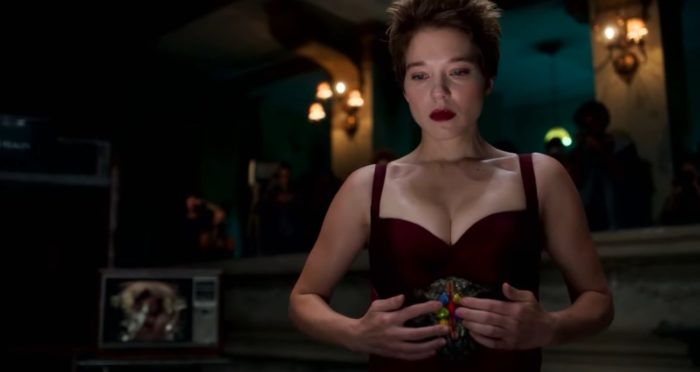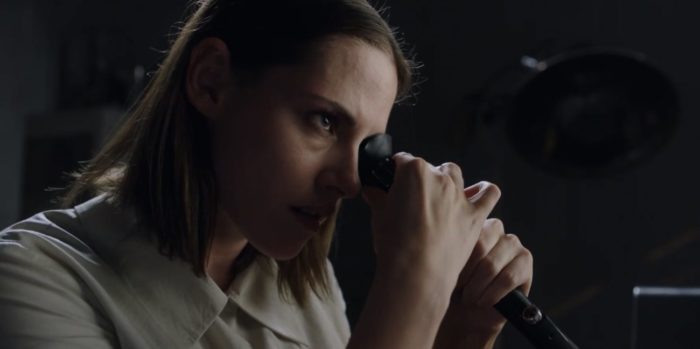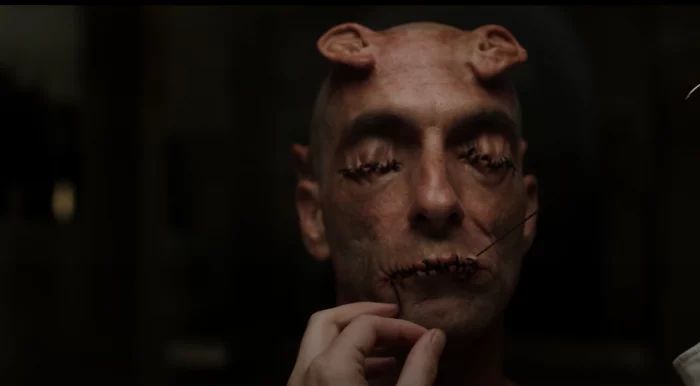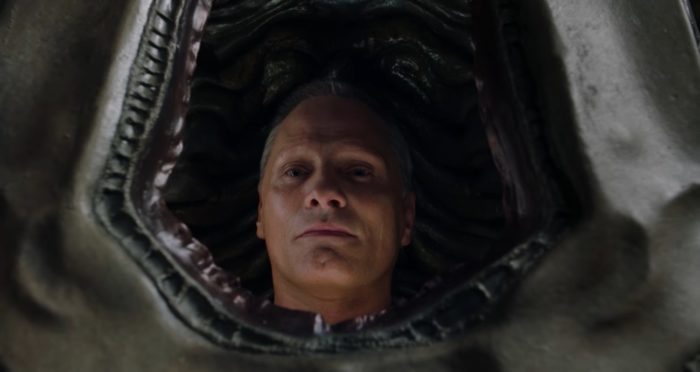David Cronenberg is a master filmmaker. That’s not even up for debate; it’s just the truth. Any film you can think of in his vast filmography delivers a tight-knit web of suspense, intrigue, and jaw-dropping shocks. Even Cosmopolis has that one moment you know is going to happen, and yet you just don’t see it coming. Whenever I see a film by a director I genuinely admire, I tend to want to rank the movie immediately after I see it. One of our current Crimes of the Future, thanks to endless internet listicles.

The thing with Cronenberg is that he’s already made a version of this movie a few times before. eXistenZ was originally titled Crimes of the Future, and another of his films from 1970 shares the same name. Though these films hardly have anything to do with one another, they seemingly make for an odd trilogy of the director’s mind, like a time capsule from the period he wrote them. The 1970 film dealt with cosmology causing a plague that kills sexually mature women. eXistenZ dealt with technology and interconnectivity through fleshy-looking devices. His latest is about subverting bodily adaptation through surgery. The more I’ve thought about it, I might even consider adding Scanners and Videodrome onto that list, too. It feels like Cronenberg has always thought ahead by considering human evolution, future technology, and baking in a heaping dose of current social commentary. In a way, all of these films work off of the same template, yet other than some aesthetic similarities, none are very alike.
I wrote as a title to one of the earlier trailer releases that the “Crimes of the Future trailer feels like Cronenberg’s greatest hits,” and, after seeing the film, I stand by that. Cronenberg takes Crash and turns car crashes into surgery with Crimes of the Future. He takes the fleshy devices from eXistenZ, turns them into Tenser’s bed and Caprice’s remote surgery controller, and makes the bone gun into digestive seats. The gooey saliva of The Fly becomes mutated slobber, and he adds a grime factor on par with Naked Lunch.
Something I immediately appreciated about Crimes of the Future was the lack of information the trailers conceptualized. Each trailer expanded on the weirdness in the new Cronenberg film, showing us a man who was all ears and Kristen Stewart repeating, “Surgery is the New Sex.” Still, they never gave a clue as to what the film was about, which is probably why some members of the Kristen Stewart fan club were in attendance in an otherwise devastatingly empty theater.

I’ll make this brief: I’m not a Kristen Stewart fan. I want to like her, and I’ve tried. I kind of loved Underwater and the Hulu film she did with Mackenzie Davis, Happiest Season, but beyond that, I find that her acting style isn’t for me. I’m sure she’s a good person, and I wish her happiness and success, but I do typically steer clear of her films (sorry, not sorry). With that said, Stewart’s part in Crimes of the Future is very brief, maybe appearing on screen for a total of twenty minutes of the one-hundred-seven-minute film, and, giving credit where it’s due, she’s quite good in it. Though I’d consider the breakout supporting actor of the film to go to Underworld’s Scott Speedman, I don’t think I’ve ever seen him this good in anything.
Getting back on track, Crimes of the Future is really about what’s next for our bodies. The film sets itself in a presumed dystopia, where humans begin to change on the inside. We see from the capsized boats, endless shipyard containers, and sandy environment that nothing in this world is the way it once was. In the midst of all this are Saul Tenser (Viggo Mortensen) and his performance partner Caprice (Léa Seydoux). Saul is one of many in this unique world who’s growing new organs, though he and Caprice have turned it into a lucrative underground exhibition by allowing people to watch as the new organs are removed from Saul’s body. Conflict arises as a new government agency seeks to register new organs in an effort to undermine and contain evolution, leading to an underground rebellion choosing Saul and Caprice’s show to reveal the government can’t stop what’s already here.
The film also treads into noirish territory, as we learn Saul’s working with a “new vice” detective (Welket Bungué) and opening his own investigations into both the new agencies and the underground mutant rebellion. There’s a lot more than meets the eye happening in many scenes, leading to more significant reveals and double-crosses by the end of the movie. However, blink, and you may miss them.

Saul is the opposite of eXistenZ‘s Ted Pikul (Jude Law), who isn’t fitted with and doesn’t want a bio-port installed to play the film’s titular diegetic game. Still, there is something about the technology Timlin (Stewart) and Caprice use in Crimes of the Future to insert their gaze into Tenser’s body that seems similar to the eXistenZ device. The similarity in both films is extensively sexual. Penetration. Insertion. Exploration. Change. Howard Shore’s score and Christopher Donaldson’s editing add extensively to the removal of Tenser’s organ, a scene that has more heat than any of the film’s actual nude scenes. Additionally, Douglas Koch’s cinematography is also quite breathtaking at times.
Crimes of the Future is maybe the most tastefully done body horror film I’ve ever seen, and that’s from the guy that turned Jeff Goldblum into a hideous blob of a human being and made his name a verb in the process. After all the commotion over walkouts at Cannes after the first five minutes, I have to say I was expecting to be more disgusted. I’ll admit, the last twenty minutes of the film are far more challenging, especially for anyone in the crowd who may have lost a child, but this is a genuinely delicate side to the king of body horror. While Crimes of the Future suggests the past, this is Cronenberg evolved. That isn’t to say there aren’t wincing moments throughout due to the film’s grotesque nature. Of course there are. Though I also believe a lot of that is halted by the use of digital effects. Cronenberg uses CGI in a few instances. All are noticeable, and I haven’t yet understood why most weren’t done practically.

On my way home from the theater, I considered how I felt about the experience. It wasn’t what I expected, but that didn’t make it bad. I quite liked the deep-seated metaphor embedded into the film, and the story is magnetic, but I also didn’t walk away from the film completely satisfied. I know I’ll be watching the movie again when it comes to VOD and DVD in August, but Crimes of the Future deserves an extended meditation. The more I think about it, the more it resonates.
You may be able to guess the allegorical meanings that exist in the subtext of the film’s plot. Climate change and allowing people to be who they are on the inside are obviously among them. Cronenberg has a lot to say about the future, and at seventy-nine years old, there’s a subtle yet urgent need to be recognized permeating through the film. He won’t be around for many more renditions of Crimes of the Future, so it’s best we listen to him now and allow our hearts to evolve.
Crimes of the Future is now playing in theaters.



